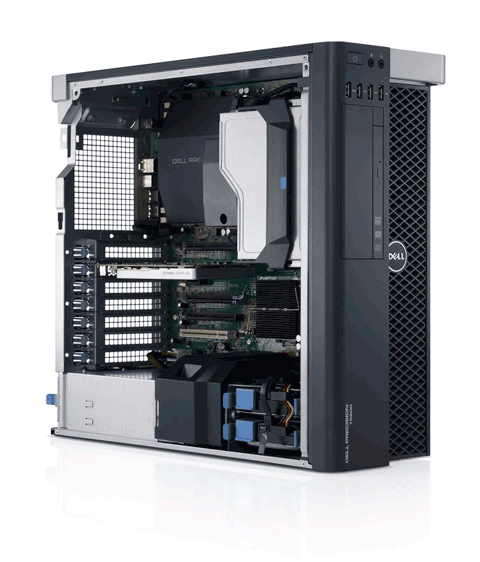
The new Precision T7600 has been completely designed from the ground up as a workstation. This is unusual for Dell who typically adapts chassis from other products.
“Internally the chassis before [Dell Precision T7500] was identical to an XPS of the same period,” says Ken Musgrave, responsible for ‘experience design’ on the new Dell Precision workstations. “Different outsides, identical insides. It was a leveraged chassis.”
Starting with a completely blank slate, one of the key design elements of the new Precision was the front grill (bezel). This is a highly functional element, but also gives the box its identity.
“The main reason the bezel exists is to provide a degree of security to the front of the system, in a sense”, says Musgrave. “What it can’t do is interfere with airflow and it has to also create a degree of appeal and personality to the product. As functional as they are there’s an undeniable emotional component to it as well.
“We spent way too much time trying to get the bezel just right, it’s ridiculous,” he jokes. “They’ve become a little bit like the grills of automobiles. “If you watch Top Gear those guys will just brutalise a grill — it’s an ordinary thing, but they’re obsessing over the grill.”
Designing how this iconic part would look was only the first challenge; the next hurdle was engineering its curved form. It needed to be strong and rigid in order to keep the front-loading hard drives secure (the side panel and front grill can be secured with a single padlock) and give the workstation a feeling of quality.
“We knew what we wanted to accomplish — we wanted this honeycomb kind of design,” explains Musgrave. “We did an extrusion of it and we wrapped it around a corner.
“We weren’t sure if we could do that though — there were a lot of people at Dell that didn’t know if we could do it at all. We did a lot of FEA [Finite Element Analysis] work on this [to make it happen].”
The grill also plays a critical role in thermally managing the interior components. Fans draw air in at the front of the machine — cooling the CPUs, memory and hard drives — before being expelled at the rear. Specially made ducts channel air from individual fans to each memory bank. Computational Fluid Dynamics (CFD) plays a big role in optimising airflow and minimizing fan noise.
The Precision T7600 does not use filters to stop unwanted dust entering the machine through the grill. “Filters are a problem. We do have filters in some areas [of Dell] when there’s a high dust environment,” says Musgrave, “But if they don’t get changed they reduce airflow and will cause more thermal shutdowns and do damage than what they protect. What we’d rather do is have all the particulates just pass all the way through, so we make the holes as big as possible.”
“We have talked about filters multiple times — and we actually have a filter set available on one of our servers — but it’s requiring the IT professionals to stay on top of it [changing them regularly]. Filters inherently reduce airflow immediately and the moment they add dust they go downhill.”
Manufacturing the grill was the final hurdle, “This was one of those products that people said can’t be moulded because there are actions and undercuts rolling around corners,” explains Musgrave adding that Dell made extensive use of mould analysis to solve the problems and take the bezel into production.
Read more on the new design for the Xeon E5-2600 Precision workstations here.






